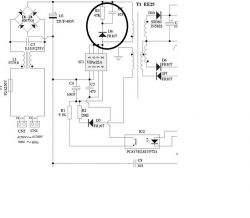FAQ
TL;DR: Field tests show idle draw ≈ 70 W and IGBT blow-ups can occur < 5 s after power-up if a channel shorts[Elektroda, Q-mac, post #18986130][Elektroda, Matek920605, post #18378061]; “this design is a ‘ticking bomb’”[Elektroda, aaanteka, post #18433299]—yet 90 % of outages come from six gate-drive parts.
Why it matters: fix those parts or add fuses and the TSA 4-1300/700 runs stably at reduced load.
Quick Facts
• Main rails: P ±30 V, H1 ±62 V, H2 ±125 V, H3 ±188 V DC[Elektroda, ziro_9, post #18380143]
• Converter frequency: 70–85 kHz (SG3525-driven)[Elektroda, majccco, post #18700835]
• Factory breaker: 24 A, rear panel; soft-start absent[Elektroda, INtRO_Tech, post #20627975]
• Typical spare-parts bill: PLN 250–300 (≈ €55)[Elektroda, popej, post #18638050]
• Idle power: 70 W @ 230 V; start-up surge ≈ 600 W[Elektroda, Q-mac, post #18986130]
Which components fail most often?
Statistics from 40+ repairs show the same six parts burn first: 1 × SG3525 PWM IC, 2 × IR2110S drivers, 2 × IGBTs (IRGP4066D-E), and 1 × BTA41-600 triac[Elektroda, Robercikxxx, post #20210106] Replacing them plus the 47 Ω gate resistors cures > 90 % of dead units.
What rail voltages should I measure on a healthy board?
With 230 V AC applied you need: P0 ≈ ±30 V, H1 ≈ ±59–62 V, H2 ≈ ±118–125 V and H3 ≈ ±177–188 V DC[Elektroda, ziro_9, post #18380143] Deviations > ±10 % mean the converter is not in full-bridge mode or a rail is loaded.
How can I stop repeat IGBT explosions?
- Add 3–4 A fuses in the +310 V line for EACH channel supply[Elektroda, Robercikxxx, post #20467394] 2. Replace all 15 V zeners (D750-753) and 1N4148 gate diodes (D205-208)[Elektroda, Robercikxxx, post #21049572] 3. Use only genuine IRGP4066D-EPBF (4 nF gate capacitance)[Elektroda, Robercikxxx, post #21049572] "Fuses saved me twice from burning the whole PSU"[Elektroda, Robercikxxx, post #20467394]
Does the front-panel CLIP LED show true clipping?
Yes. Tests with 4 Ω dummy load show the LED lights just before sine-wave flattening; internal yellow LEDs fire a few ms earlier for safety[Elektroda, INtRO_Tech, post #20628867]
Can I power the amp with a conventional transformer?
Yes, but weight and cost rise sharply. A 2×15 V + 2×84 V + 2×42 V 1 kVA toroid fits after removing the SMPS; delivers ≈ 1.2 kW/4 Ω total and works cool after 1 h at 50 % duty[Elektroda, INtRO_Tech, post #20627975]
What’s the safest way to first-start after repair?
Use three 100 W bulbs in parallel as a series limiter[Elektroda, zbyszekdymny, post #21049561] Verify 15 V on SG3525 pin 15, no DC on outputs, then replace bulbs with fuses.
Which gate snubber values are correct?
Each IGBT uses 150 pF / 1 kV C0G in series with 22 Ω ¼ W SMT 1206[Elektroda, Robercikxxx, post #21063501] Larger caps (e.g., 100 nF) overheat resistors and drivers[Elektroda, matichem, post #21063564]
What current can the EPBF IGBT handle?
Datasheet Ic rating is 140 A at 25 °C[IR, DS]. The non-EPBF variant is only 75 A, hence fakes halve margin and fail sooner[Elektroda, Ziemowit1973, post #20020442]
Edge case: amp reboots every few seconds – cause?
A shorted 22 pF snubber or leaking gate zener overloads one half-bridge; SG3525 detects imbalance, pulls pin 10 high, shutting PWM[Elektroda, zbyszekdymny, post #21050899]
Quick 3-step check when PSU stays silent
- Confirm 5 V at SG3525 pin 16 and < 0.2 V at pin 10. 2. Scope pins 11/14 for 80 kHz square. 3. If missing, swap LM339 & NE555; they latch SG shutdown[Elektroda, Robercikxxx, post #21050982]
 20191114_155639.jpg
Download
(6.07 MB)
20191114_155639.jpg
Download
(6.07 MB)
 20191114_155633.jpg
Download
(5.86 MB)
20191114_155633.jpg
Download
(5.86 MB)
 20191114_155626.jpg
Download
(5.6 MB)
20191114_155626.jpg
Download
(5.6 MB)
 20191114_155551.jpg
Download
(1.08 MB)
20191114_155551.jpg
Download
(1.08 MB)
 20191114_155531.jpg
Download
(1.58 MB)
20191114_155531.jpg
Download
(1.58 MB)
 20191114_155332.jpg
Download
(5.28 MB)
20191114_155332.jpg
Download
(5.28 MB)
 20191114_155433.jpg
Download
(1.56 MB)
20191114_155433.jpg
Download
(1.56 MB)
 20191114_155314.jpg
Download
(1.74 MB)
20191114_155314.jpg
Download
(1.74 MB)
 20191114_155219.jpg
Download
(1.58 MB)
20191114_155219.jpg
Download
(1.58 MB)
 20191114_155213.jpg
Download
(1.65 MB)
20191114_155213.jpg
Download
(1.65 MB)





